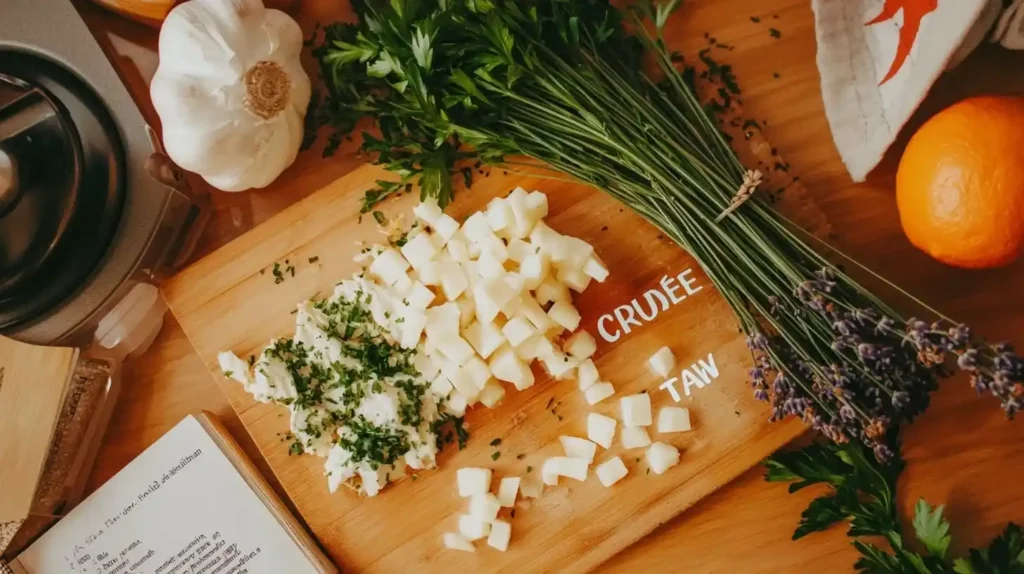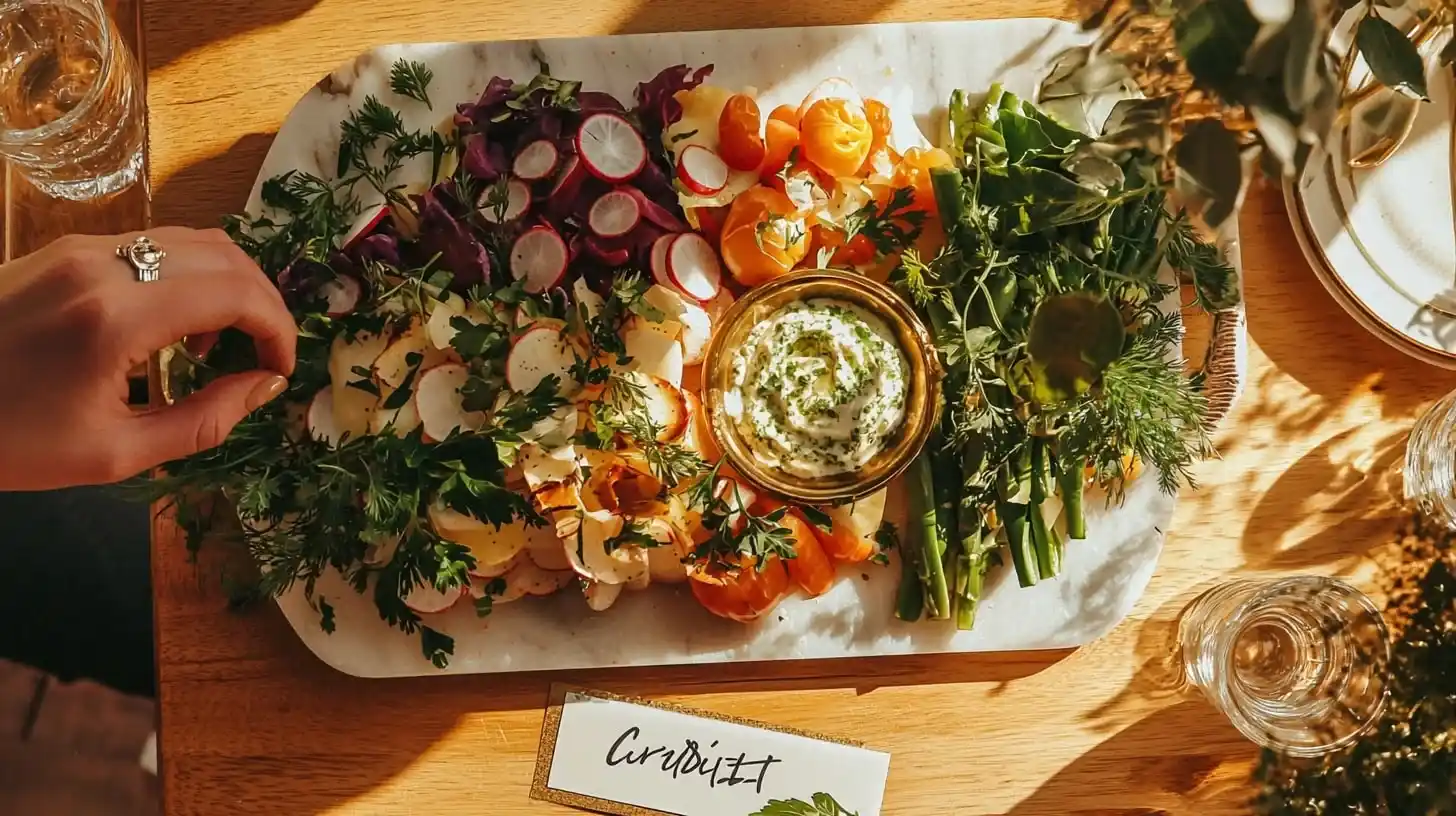“What do you call this beautiful vegetable arrangement?” a guest asked at my daughter’s graduation party, pointing to the colorful display I’d created that morning.What Is a Fancy Vegetable Tray Called?.
“It’s a crudité platter,” I replied, using the term my grandmother had taught me years ago in her Kentucky kitchen.
The guest smiled appreciatively, clearly impressed by both the presentation and the sophisticated terminology.
The fancy name for an artfully arranged Vegetable Tray is “crudités” (pronounced kroo-dee-TAY) – a French culinary term that instantly elevates a simple vegetable arrangement into something seemingly more sophisticated.
This elegantly-named offering has become a staple at gatherings ranging from casual family dinners to upscale events, proving that sometimes a fancy name can transform perception without changing the essence of what’s being served.
Table of Contents
What Is a Fancy Vegetable Tray Called? What Are Crudités? Definition and Origin

Crudités (kroo-dee-TAY) is simply the French term for raw vegetables cut into pieces and typically served with some type of dip.
The word comes from the French “cru,” meaning raw, highlighting that these vegetables are served in their natural, uncooked state.
This elegant term has been adopted into English to describe more upscale or artfully arranged vegetable presentations.
My grandmother first introduced me to the term during a family wedding preparation, explaining that “sometimes a fancy name makes people appreciate simple things more deeply.”
While deciding What are the best veggies for a veggie tray, remember that traditional crudités often feature a more diverse selection, including vegetables rarely seen on casual platters.
For additional colorful, fresh serving ideas, our Fresh & Vibrant Lunch Ideas: Colorful & Nutritious Options collection offers inspiration beyond traditional vegetable arrangements.
Pronouncing Crudités Correctly
What Is a Fancy Vegetable Tray Called? Show Pronunciation Guide Image Say it with confidence! ‘Crudités’ (kroo-dee-TAY) – the elegant French term that instantly elevates your vegetable presentation.
The proper pronunciation of crudités is “kroo-dee-TAY” with emphasis on the final syllable.
Common mispronunciations include “crude-ites” or “crew-dites” – versions my husband playfully used until my persistent corrections finally took hold.
The French pronunciation includes three key elements:
- The “cr” is pronounced with a “k” sound
- The middle syllable is pronounced “dee”
- The final “tés” is pronounced “tay” with the emphasis
My middle child practiced the pronunciation repeatedly before a school presentation, determined to impress her teacher with proper French terminology.
Even if your pronunciation isn’t perfect, most people appreciate the effort to use the proper term – my grandmother assured me that “intention matters more than perfection” when adopting culinary terminology.
Crudités vs. Regular Vegetable Trays
What Is a Fancy Vegetable Tray Called? While crudités and vegetable trays contain essentially the same core ingredients, several elements distinguish a true crudité presentation:
Artistic arrangement: Crudités typically feature more sophisticated presentation than casual vegetable trays, often arranged in patterns rather than simple sections.
Vegetable selection: Traditional crudités might include more unusual or elegant vegetables like endive, watermelon radish, or asparagus tips alongside familiar options.
Accompaniments: While regular vegetable trays often feature ranch dip, crudités typically pair with more elevated options like aioli, hummus, or herb-infused dips.
Serving pieces: Crudités are generally presented on more elegant serving pieces – marble, ceramic, or wood – rather than plastic trays.
For those wondering about specific preparation methods, questions like Do I peel cucumbers for a veggie tray? become especially relevant for upscale presentations, where details matter significantly.
For families balancing presentation with practicality, Is it cheaper to make or buy a veggie tray? offers valuable insight into the economics of elegant vegetable presentations.
Creating Crudité-Worthy Presentations
What Is a Fancy Vegetable Tray Called? Several techniques can elevate a basic vegetable arrangement to true crudité status:
Focus on color contrast: Arrange vegetables to maximize visual impact through deliberate color placement – a technique my artist daughter calls “edible color theory.”
Create height variation: Build dimension by leaning or stacking certain vegetables rather than laying everything flat – my grandmother called this “giving your vegetables some personality.”
Include unexpected elements: Add fresh herbs, edible flowers, or unique vegetables to distinguish your presentation from ordinary trays.
Pay attention to cutting techniques: Create uniform, precision cuts or deliberately varied shapes depending on your desired aesthetic effect.
Serve with elevated dips: Prepare homemade options with fresh herbs, quality ingredients, and attractive presentation.
For comprehensive meal inspiration beyond appetizers, our Family-Friendly Lunch Recipes: Effortless Meals for Busy Parents collection offers additional ideas for creating memorable family meals.
Answers to Your Crudité Questions
Is it pretentious to call my vegetable tray “crudités”? Not at all – it’s simply using the correct culinary terminology. My practical-minded sister initially resisted the term until I explained it’s equivalent to using “hors d’oeuvres” instead of “appetizers” – accurate terminology rather than pretension.
Do restaurants always use the term crudités? Many upscale restaurants use this term on their menus, while casual establishments might opt for “fresh vegetable platter” or similar phrasing. The term signals a certain level of culinary sophistication.
What’s the singular form of crudités? The singular form is “crudité” (kroo-dee-TAY), though it’s rarely used since these vegetables are typically served as a collection rather than individually.
Are crudités always served cold? Traditionally yes – the term specifically refers to raw vegetables. Cooked vegetable platters would be called “roasted vegetable platters” or something similar, not crudités.
Elevating Your Vegetable Presentations
What Is a Fancy Vegetable Tray Called? Whether you call it a vegetable tray or crudités largely depends on your audience and the impression you want to create.
For casual family gatherings, simple terminology creates an approachable atmosphere.
For more formal occasions, using the proper French term signals attention to culinary detail and presentation.
My grandmother’s wisdom applies perfectly here: “The name changes perception without changing substance” – a reminder that terminology influences how people experience food.
The crudité concept reminds us that presentation transforms the ordinary into the special – a principle applicable far beyond vegetable arrangements.
By arranging familiar ingredients with intentional artistry and calling them by their proper culinary name, we elevate the everyday into something that feels special and sophisticated.
This simple terminology shift represents the essence of thoughtful entertaining – creating memorable experiences through attention to detail rather than complicated techniques or expensive ingredients.
With warmth, Sophia





